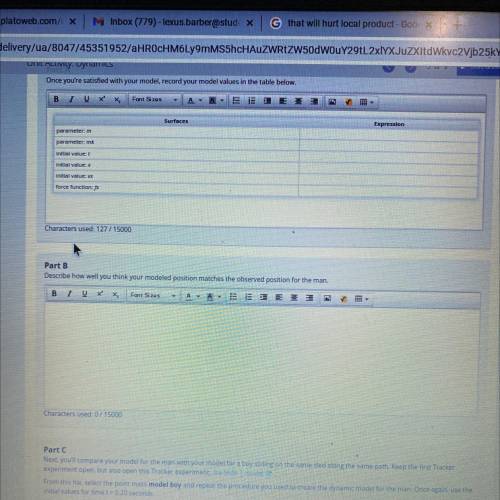
Physics, 27.10.2021 14:00 cameronbeaugh
Now that you know how forces affect the motions of objects, you can use the Tracker video analysis tool to create dynamic models
for a wide range of physical situations.
Tracker enables you to create two different types of mathematical models: analytical and dynamic. An analytical model enables you
to enter mathematical expressions for x and y positions as a function of time. That's sometimes useful, but from a physics
perspective, a dynamic model is much more flexible and powerful.
A dynamic model enables you to set the initial conditions for a particular system (Initial positions and velocities); then you can
mathematically define any forces acting on that system. Once those are set up, the model acts like an object in space, responding to
the forces you've imposed on it. It can continue moving forever, if that's what the forces would do to an object in real life. By visually
matching a marker for your model to the real motion on the video, you can define and refine a mathematical model for a wide range
of real-world situations.
In the first two tasks of this Unit Activity, you'll create dynamic models for motions in both one and two dimensions.
Activity Research - Creating a Dynamic Particle Model
Before you begin, do a little research and find out where you can get help in creating your models. In Tracker, you can always access
illustrated help to do anything. In Tracker, you can always access the illustrated Help dialog (? In the Toolbar).
For this project, you're going to need to check out the Tracker Help Instructions for Dynamic Models. You can print this Help
document, but it is available from Tracker anytime you need to refer to it.
For this project, you're going to need to check out the Tracker Help Instructions for creating a dynamic model.
Instructions - Building your Dynamic Model


Answers: 1


Another question on Physics

Physics, 21.06.2019 13:30
After an atomic bomb has been dropped, the damage continues to get worse. why is this?
Answers: 1

Physics, 21.06.2019 18:40
The intensity, or loudness, of a sound can be measured in decibels (db), according to the equation , where i is the intensity of a given sound and is the threshold of hearing intensity. what is the intensity, in decibels, [i(db)], when ? use a calculator. round to the nearest whole number. 8 9 19 80
Answers: 1

Physics, 22.06.2019 05:30
If gases like carbon dioxide and methane make up less than 1% of the total atmosphere, why is it important for scientists to monitor changes in percentages of these gases?
Answers: 1

Physics, 22.06.2019 06:40
Alinearly polarized electromagnetic wave has an average intensity of 196 w/m^2. this wave is directed towards two ideal polarizers (in real polarizers, transmission is also effected by reflection and absorption). polarizer a is oriented with its transmission axis at an angle of θ_1=20.8∘ with the incident electric field. polarizer b has its axis at an angle of θ_2=63.0∘ with the incident electric field. what is the average intensity of the wave after it passes through polarizer a? what is the average intensity of the wave after it passes through polarizer b? suppose that the two polarizers a and b are interchanged. what would the average intensity be after passing through both polarizers?
Answers: 2
You know the right answer?
Now that you know how forces affect the motions of objects, you can use the Tracker video analysis t...
Questions

Biology, 03.08.2019 22:30

Biology, 03.08.2019 22:30

Biology, 03.08.2019 22:30


Biology, 03.08.2019 22:30

History, 03.08.2019 22:30

Business, 03.08.2019 22:30

Mathematics, 03.08.2019 22:30

Mathematics, 03.08.2019 22:30


Mathematics, 03.08.2019 22:30

Business, 03.08.2019 22:40

Biology, 03.08.2019 22:40

Biology, 03.08.2019 22:40

Mathematics, 03.08.2019 22:40

Mathematics, 03.08.2019 22:40


Biology, 03.08.2019 22:40


Social Studies, 03.08.2019 22:40



